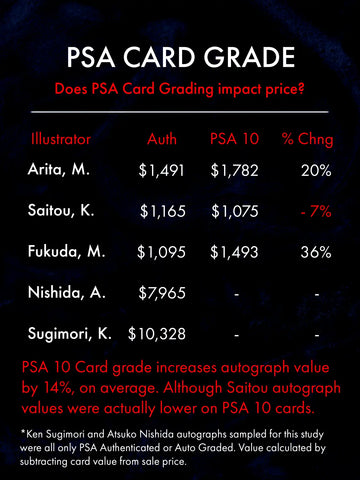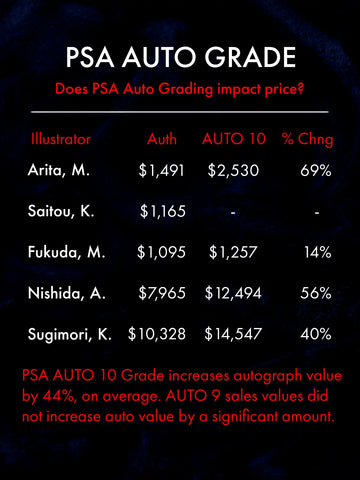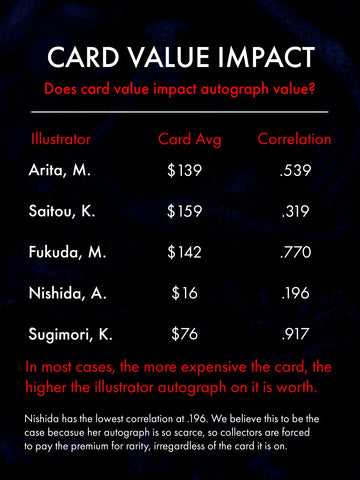Pokémon Illustrators & Their Autographs (Part 4)
An Editorial by AestheticChimp
Impact that PSA Card and
Auto Grades Have on Sale Price
CARD GRADE
One of the well-recorded influences on a card’s value in any TCG is the condition of the card. In raw cards, the DM, HP, MP, LP, NM scale for rough condition assessment is thrown out constantly online and in convention negotiations. Naturally, it would follow that professional services such as PSA, BGS, CGC and others would provide a foundation of valuation based on condition (with PSA being the gold standard). However, autographed cards fall into a slightly different niche.

Autograph cards are, by definition, handled cards. The cards have been held, handled, taken to a signing event and placed in the hands of the illustrator. As a result, it is not as common for cards that were autographed at these events to also receive a PSA 10 grade. Conversely, many collectors of autographs do not care about the grade as much as the card and the autograph on it. We actually fall into this category, ourselves. Generally, we care more about the autograph on the card than the condition of the card itself. This is just our opinion, however, let’s take a look at the data: Arita and Fukuda illustrated cards, when signed and PSA 10, saw an increase in the value of the autograph (calculated by the following formula: Final Sale Price - Card Value = Autograph Value).
Arita saw a 20% increase in the value of his autograph between a PSA AUTH card grade and PSA 10 card grade. Fukuda saw a 36% increase. Interestingly, however, Saitou actually saw a 7% DECREASE in value in PSA 10 graded copies. We suspect this is because the majority of the sales data for Saitou were modern cards (such as the poncho wearing Pikachu full arts). As such, there would not be as significant a premium for PSA 10 valuation
AUTO GRADE
Another sort of grade that we can look at for consideration is the Autograph Grade. PSA and BGS both work on a AUTH-10 scale for grading the clarity, smoothness, and visual appeal Auto Sales Data - Cole and Vince of an autograph. This grading scale appears to have significantly more impact on the value of an autograph than any other factor we will look at in this post. The lowest autograph grade for a Pokémon illustrator that we have seen is a 7, with the vast majority falling between 8 and 9. A select few received the distinction of an autograph grade of a 10. Auto grades of 9 and below did not appear to cause a significant change in autograph value.

In the data we collected, every single artist autograph saw a significant increase in value from AUTO AUTH to AUTO 10 (with the exception of Saitou who had insignificant data to make a determination). Arita saw a 69% increase in autograph value, Fukuda a 14% increase, Nishida a 56% value increase and Sugimori saw a 40% increase. The reason for this increase is up for speculation, but it is out opinion that autograph buyers are generally more interested in obtaining a high quality, smooth autograph than anything else. Think about it this way: Who cares if the card you have signed is a PSA 10 if the autograph itself looks like chicken

Stay tuned for part 5 ... and the rest of the story!
For follow information, questions or commentary, please us the following contact information
IG: @AestheticChimp
IG: @dickandjanes1989
Copyright @ Dick & Jane's / DJ Filips Entertainment, Inc 2022

